BERANDA ABOUT US ADS : 1 USD FOREVER ASMARA BIOGRAFI BUKU BUKU PINTAR
CHRISTIAN FAITH DISCLAIMER DUNIA KERJA ENTREPRENEURS GO PUBLIC (IPO)
KESEHATAN LIST OF ALL ARTICLES MARKETING MY STARTUP OTHERS
TIP SUKSES DAN KAYA TIPS BLOGGER TIP SEO CONTACT ME PROFESSIONAL WRITER
Local Business SEO: How To Optimize Your WordPress Website In Under An Hour
26% of the web is built on WordPress and with good reason. Whether you are an experienced developer or HTML illiterate, WordPress provides an amazing base from which virtually anything can be built.
As a local business owner or marketer for local businesses, there’s a good chance you fall closer to the “HTML illiterate” side of that equation, and that’s okay.
In this guide, we’ll be taking you step-by-step through the process of optimizing your local business SEO via WordPress. We’ll show you every plugin and tool you need to maximize the benefits while minimizing the time and money you’re required to invest.
This process is a crucial step of the SEO process Be Top Local used to take a Utah business to $100k in monthly profits.
Everything in this guide can be completed in less than an hour. That said, you will probably want to take a bit more time on some of the sections in order to better understand them. Whether you churn and burn or turn this into a more well-rounded learning experience, you WILL have an SEO optimized WordPress website by the end!
If you’d rather just download this guide as a convenient PDF checklist, click below:

But first, let’s quickly discuss why WordPress is the right choice…
26% of the web is built on WordPress and with good reason. Whether you are an experienced developer or HTML illiterate, WordPress provides an amazing base from which virtually anything can be built.
As a local business owner or marketer for local businesses, there’s a good chance you fall closer to the “HTML illiterate” side of that equation, and that’s okay.
In this guide, we’ll be taking you step-by-step through the process of optimizing your local business SEO via WordPress. We’ll show you every plugin and tool you need to maximize the benefits while minimizing the time and money you’re required to invest.
This process is a crucial step of the SEO process Be Top Local used to take a Utah business to $100k in monthly profits.
Everything in this guide can be completed in less than an hour. That said, you will probably want to take a bit more time on some of the sections in order to better understand them. Whether you churn and burn or turn this into a more well-rounded learning experience, you WILL have an SEO optimized WordPress website by the end!
If you’d rather just download this guide as a convenient PDF checklist, click below:

But first, let’s quickly discuss why WordPress is the right choice…
You’re Better Off On WordPress
There are only two types of people for whom WordPress might NOT be the right choice:
- People who don’t plan to make money via their site and have zero time to learn the most basic of web skills.
- People who are making so much money they can outsource 100% of their website activity to a high-end development and marketing agency.
In other words, if you plan to make between $1,000 – $500,000 per month via your website, WordPress is ALWAYS the right choice for you.
Here’s why:
- Very low learning curve
- Unlimited control and customization possibilities
- Dedicated team keeping platform security up to speed
- Over 10,000 themes to build from
- 44,000+ plugins let you do virtually anything with zero development skills
- Trusted by over a quarter of the web
- Endless community tutorials and Q&A’s help you accomplish anything desired
Put simply, no other platform offers the same level of both simplicity and flexibility. WordPress adapts to your skill level, letting you do as much or as little as you want and end up with an excellent result every time.
Premium themes are cheap ($50-100) and many will give you a solid SEO structure, clean code, and high load speed right out of the box. I’d personally recommend StudioPress as their Genesis framework is optimized for SEO and their selection of themes are head and shoulders above most.
If you aren’t currently on WordPress and are interested in taking your local SEO and online marketing seriously, it’s probably worth your time and effort to make the switch.
There are only two types of people for whom WordPress might NOT be the right choice:
- People who don’t plan to make money via their site and have zero time to learn the most basic of web skills.
- People who are making so much money they can outsource 100% of their website activity to a high-end development and marketing agency.
In other words, if you plan to make between $1,000 – $500,000 per month via your website, WordPress is ALWAYS the right choice for you.
Here’s why:
- Very low learning curve
- Unlimited control and customization possibilities
- Dedicated team keeping platform security up to speed
- Over 10,000 themes to build from
- 44,000+ plugins let you do virtually anything with zero development skills
- Trusted by over a quarter of the web
- Endless community tutorials and Q&A’s help you accomplish anything desired
Put simply, no other platform offers the same level of both simplicity and flexibility. WordPress adapts to your skill level, letting you do as much or as little as you want and end up with an excellent result every time.
Premium themes are cheap ($50-100) and many will give you a solid SEO structure, clean code, and high load speed right out of the box. I’d personally recommend StudioPress as their Genesis framework is optimized for SEO and their selection of themes are head and shoulders above most.
If you aren’t currently on WordPress and are interested in taking your local SEO and online marketing seriously, it’s probably worth your time and effort to make the switch.
Ground ZERO: Optimize Your Site Speed
Let me put it this way. If your site is slow, you lose sales.
As many as 25% of visitors may abandon a site after just 4 seconds of load time, and it’s recommended that your site’s pages take no longer than 4 seconds to load in order to maximize retention.
If you aren’t sure where you website stands on speed, simply enter a page URL from your site into this speed test tool from Pingdom.
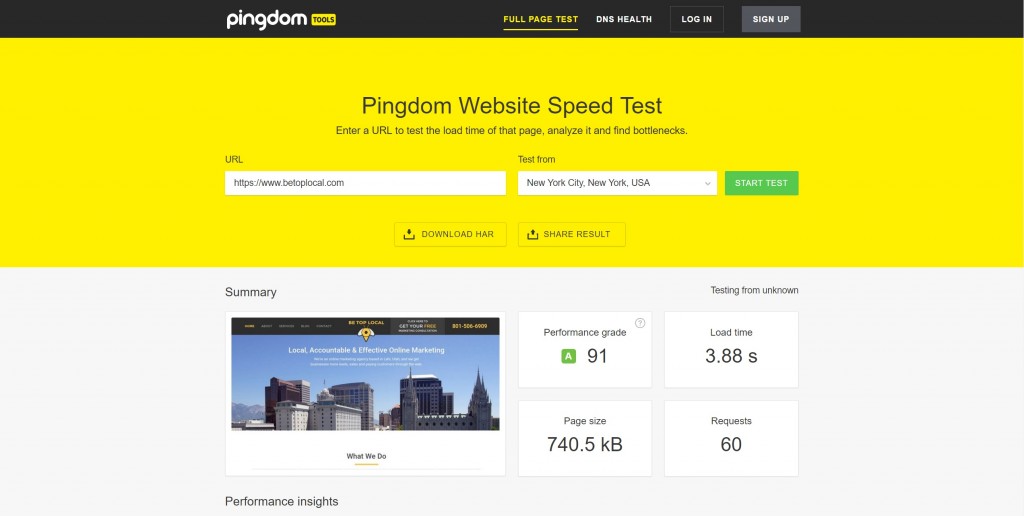
If you are getting load times in excess of 4 seconds, it’s definitely time to act.
Step 1. Choose a good host
Site speed starts with good hosting. If you have a relatively small website (less than 20 pages) and check off all the other boxes on this page but still can’t get load times of under 4 seconds, the problem is probably your hosting.
For smaller businesses, Siteground for WordPress and even Godaddy for WordPress are solid options. If you are a bit larger, making a good bit more money, and want something a bit more high-end, WP Engine comes highly reviewed.
Step 2. Use an uncluttered theme/framework
If you wish to use one of WordPress’ free default themes, that is completely fine. The default framework is lightweight and works fine for most sites. Fantastic premium alternatives include StudioPress, as I mentioned earlier, Thesis Themes, and Elegant Themes.
Again, before you worry to much about your existing theme or hosting, work through the rest of this list and then come back to this if you still aren’t getting good results. If you are starting from scratch, I’d highly recommend spending the extra $100 to go with one of the premium options above.
Step 3. Use an effective caching plugin
Proper caching can have a massive impact on site load speeds. For great performance without needing to learn anything, just install W3 Total Cache, activate it, and call it a day.
Step 4. Optimize images (automatically)
Large images have been the bane of website load times since the earliest days of the internet. With today’s technology, however, unoptimized images is usually a product of ignorance rather than a lack of means.
Thanks to the WordPress community, you can retain your ignorance and still optimize your images. Simply install the WP-SmushIt plugin and watch your load time decrease. The plugin compresses your images without sacrificing quality,
To get more advanced…
That’s the basics of optimizing for site speed and should cover everything you need for a small to mid-sized website. If you have followed all four steps and are still unsatisfied with your load speeds, check out Ciotti’s article for more optimization techniques.
Let me put it this way. If your site is slow, you lose sales.
As many as 25% of visitors may abandon a site after just 4 seconds of load time, and it’s recommended that your site’s pages take no longer than 4 seconds to load in order to maximize retention.
If you aren’t sure where you website stands on speed, simply enter a page URL from your site into this speed test tool from Pingdom.

If you are getting load times in excess of 4 seconds, it’s definitely time to act.
Step 1. Choose a good host
Site speed starts with good hosting. If you have a relatively small website (less than 20 pages) and check off all the other boxes on this page but still can’t get load times of under 4 seconds, the problem is probably your hosting.
For smaller businesses, Siteground for WordPress and even Godaddy for WordPress are solid options. If you are a bit larger, making a good bit more money, and want something a bit more high-end, WP Engine comes highly reviewed.
Step 2. Use an uncluttered theme/framework
If you wish to use one of WordPress’ free default themes, that is completely fine. The default framework is lightweight and works fine for most sites. Fantastic premium alternatives include StudioPress, as I mentioned earlier, Thesis Themes, and Elegant Themes.
Again, before you worry to much about your existing theme or hosting, work through the rest of this list and then come back to this if you still aren’t getting good results. If you are starting from scratch, I’d highly recommend spending the extra $100 to go with one of the premium options above.
Step 3. Use an effective caching plugin
Proper caching can have a massive impact on site load speeds. For great performance without needing to learn anything, just install W3 Total Cache, activate it, and call it a day.
Step 4. Optimize images (automatically)
Large images have been the bane of website load times since the earliest days of the internet. With today’s technology, however, unoptimized images is usually a product of ignorance rather than a lack of means.
Thanks to the WordPress community, you can retain your ignorance and still optimize your images. Simply install the WP-SmushIt plugin and watch your load time decrease. The plugin compresses your images without sacrificing quality,
To get more advanced…
That’s the basics of optimizing for site speed and should cover everything you need for a small to mid-sized website. If you have followed all four steps and are still unsatisfied with your load speeds, check out Ciotti’s article for more optimization techniques.
Local Business SEO 101: Pick The Right Keyphrases
All SEO starts with keyphrases, and local SEO is no different. You can’t position your website correctly unless you know what people are searching for.
Are people searching more often for “local roofing company” or “affordable roofing”? Are they searching by brand name for your competition or looking for a generic solution? The answers to these questions will dictate your strategy.
SEO is a $65 billion industry, so as you imagine, there are some fairly complex strategies and expensive tools you can use to increase your rankings, but that’s not what we’ll be focusing on.
For the purposes of local SEO, we want something simple, cheap and effective. Fortunately, Google gives us virtually everything we need.
Step 1: Brainstorm what your customers are searching for
The first step is to get in the mind of your customers. What are they searching for when they want to find a business like yours?
Come up with a list of 5-10 possible phrases.
For example:
If you own a roofing business in Atlanta, your target customers might search the following phrases:
- Fix my roof
- I need new roofing
- Atlanta roofing company
- Affordable roofing
- Best roofers in Atlanta
Once you’ve come up with at least 5 phrases to test, its’ time for phase 2.
Step 2: Enter phrases into Google search
Go ahead and enter your brainstormed phrases into Google search. As you begin to enter them, Google will automatically attempt to predict what you’re searching for based on other popular searches.
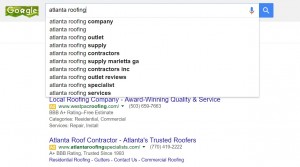
This immediately gives you a host of other keywords to add to your list. Try entering in each of your brainstormed phrases and looking through the new suggested keyphrases for options a prospective customer might use.
Once you’ve fully entered the phrase, scroll to the bottom of the page for another batch of suggested keyphrases.
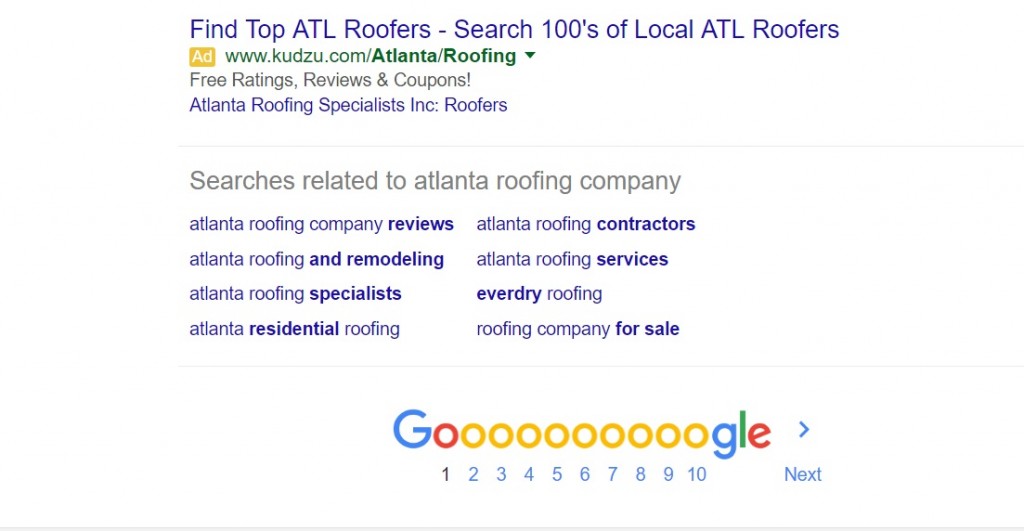
There will probably be a fair amount of overlap between these two methods, but keep doing this until you have around 30 total keyphrases on your list.
Step 3: Enter list into Keyword Planner
Next, head on over to Google Adword’s Keyword Planner, and copy/paste your list into the “search for new keywords” section.
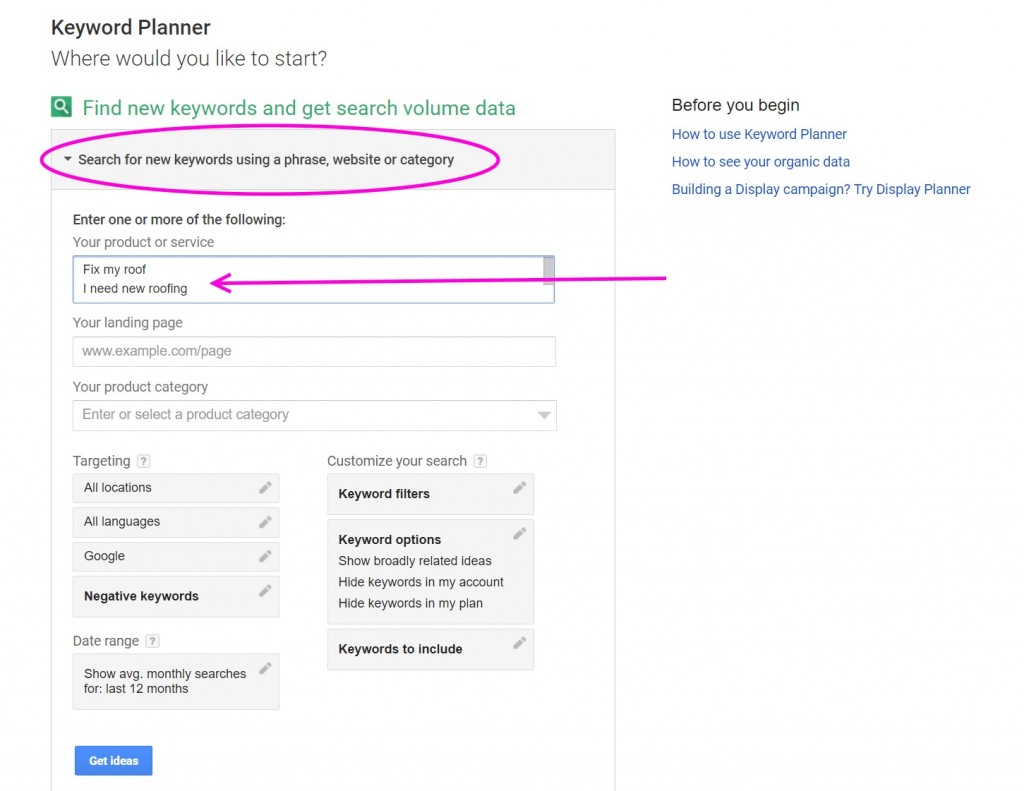
This search will generate traffic volume for your selected keyphrases as well as suggesting new keyphrases and displaying traffic data, keyphrase competitiveness, and the average PPC bid for each phrase.
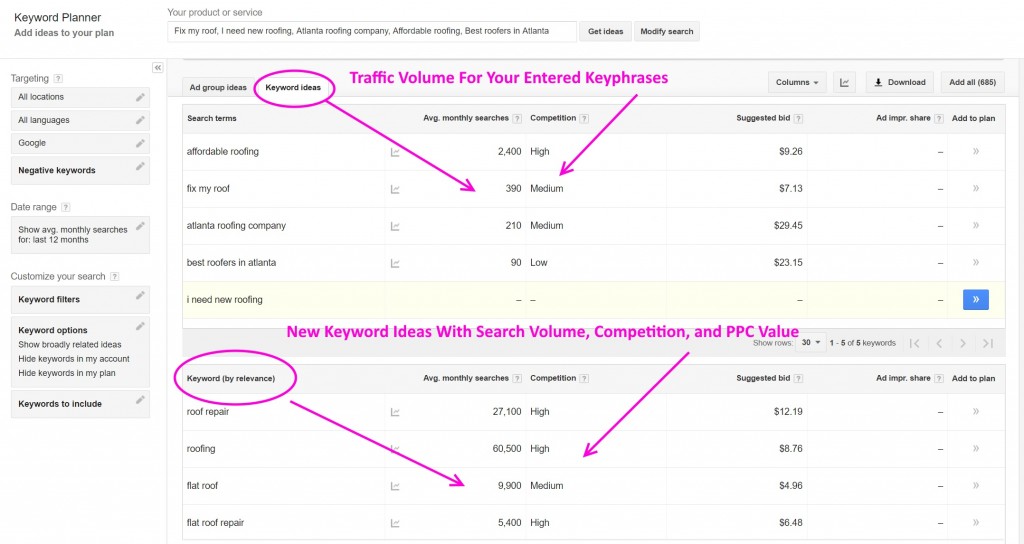
Your list of keyphrases will now be ranked by volume and you can use this info to target the most popular phrases on your site (as we’ll discuss throughout the rest of this guide).
Typically, keyphrases that show around 300 “Avg. monthly searches” and don’t say “High” under the “Competition” section make for good targets. You’ll want to come out of this process with at least 10 keyphrases that get between 200-1,000 monthly searches and are highly relevant to your business.
To get more advanced…
If you’re at the point where you have already implemented most of these steps and you are looking for more advanced keyphrase research strategies, check out this guide from Brian Dean.
All SEO starts with keyphrases, and local SEO is no different. You can’t position your website correctly unless you know what people are searching for.
Are people searching more often for “local roofing company” or “affordable roofing”? Are they searching by brand name for your competition or looking for a generic solution? The answers to these questions will dictate your strategy.
SEO is a $65 billion industry, so as you imagine, there are some fairly complex strategies and expensive tools you can use to increase your rankings, but that’s not what we’ll be focusing on.
For the purposes of local SEO, we want something simple, cheap and effective. Fortunately, Google gives us virtually everything we need.
Step 1: Brainstorm what your customers are searching for
The first step is to get in the mind of your customers. What are they searching for when they want to find a business like yours?
Come up with a list of 5-10 possible phrases.
For example:
If you own a roofing business in Atlanta, your target customers might search the following phrases:
- Fix my roof
- I need new roofing
- Atlanta roofing company
- Affordable roofing
- Best roofers in Atlanta
Once you’ve come up with at least 5 phrases to test, its’ time for phase 2.
Step 2: Enter phrases into Google search
Go ahead and enter your brainstormed phrases into Google search. As you begin to enter them, Google will automatically attempt to predict what you’re searching for based on other popular searches.

This immediately gives you a host of other keywords to add to your list. Try entering in each of your brainstormed phrases and looking through the new suggested keyphrases for options a prospective customer might use.
Once you’ve fully entered the phrase, scroll to the bottom of the page for another batch of suggested keyphrases.

There will probably be a fair amount of overlap between these two methods, but keep doing this until you have around 30 total keyphrases on your list.
Step 3: Enter list into Keyword Planner
Next, head on over to Google Adword’s Keyword Planner, and copy/paste your list into the “search for new keywords” section.

This search will generate traffic volume for your selected keyphrases as well as suggesting new keyphrases and displaying traffic data, keyphrase competitiveness, and the average PPC bid for each phrase.

Your list of keyphrases will now be ranked by volume and you can use this info to target the most popular phrases on your site (as we’ll discuss throughout the rest of this guide).
Typically, keyphrases that show around 300 “Avg. monthly searches” and don’t say “High” under the “Competition” section make for good targets. You’ll want to come out of this process with at least 10 keyphrases that get between 200-1,000 monthly searches and are highly relevant to your business.
To get more advanced…
If you’re at the point where you have already implemented most of these steps and you are looking for more advanced keyphrase research strategies, check out this guide from Brian Dean.
SEO 3000: Optimize Your Site-wide Settings
Once we’ve identified our keyphrases, it’s time to optimize our website around those phrases. In other words, we are trying to set up our website so that when Google’s bots scan us for indexing, they are attaching our site to keyphrases like “Atlanta roofing company” and “fix my roof Atlanta”.
The best part about this step is that it’s completely in our control. We can do everything from our own WordPress dashboard. Simply follow these steps.
Step 1: Install an all-purpose SEO plugin
Once again, the best part about WordPress is that there are so many plugins that make life easy. When it comes to site-wide SEO setup, there are several plugin options that will do virtually all the heavy lifting for you.
The two most popular options include:
My personal favorite is Yoast SEO, so that’s the one I’ll pull screenshots from in this tutorial, but both plugins will do essentially the same thing with only a few variations here or there.
Step 2: Set your homepage meta data
Your meta data is the core information sent to Google and other search engines concerning your website. When we talk about meta data in the context of SEO, we are typically talking about your domain’s title and description.
You’ll want to include your brand name and your top keyphrase in your site’s meta title, while limiting the total character count to around 67 characters.
For your meta description, follow these guidelines:
- Keep it around 135 characters
- Use action-based wording and include a direct Call To Action (CTA)
- Make sure to include your primary keyphrase
In order to enter your homepage meta data, look for “Titles & Metas” in your Yoast SEO plugin settings or a similar variant if you are using a different plugin.
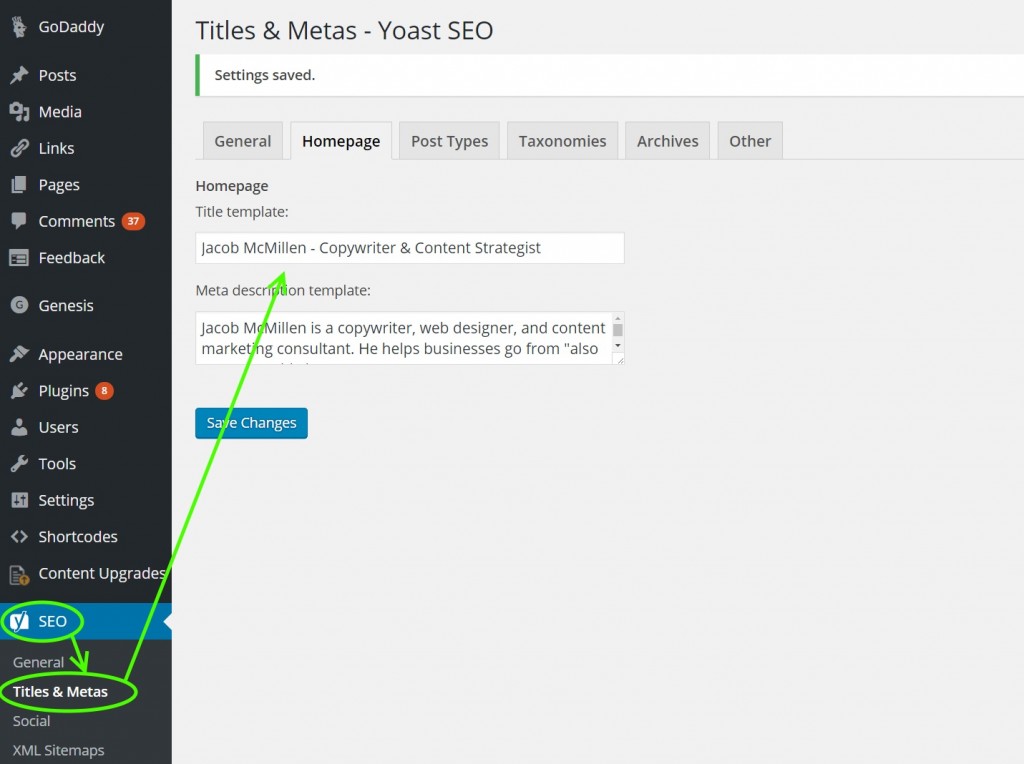
Step 3: Adjust your permalinks
Your permalinks are the way WordPress configures your URLs for new posts and pages. The default setting typically includes some sort of date, category, or other data in the URL which isn’t optimal, so we’ll want to change that right off the bat when setting up a new site. If your site is older and already has a ton of content, you can either skip this step or follow the directions here.
Simply go to Settings > Permalinks and then check the bubble next to “Post name” – http://yourdomain.com/sample-post/
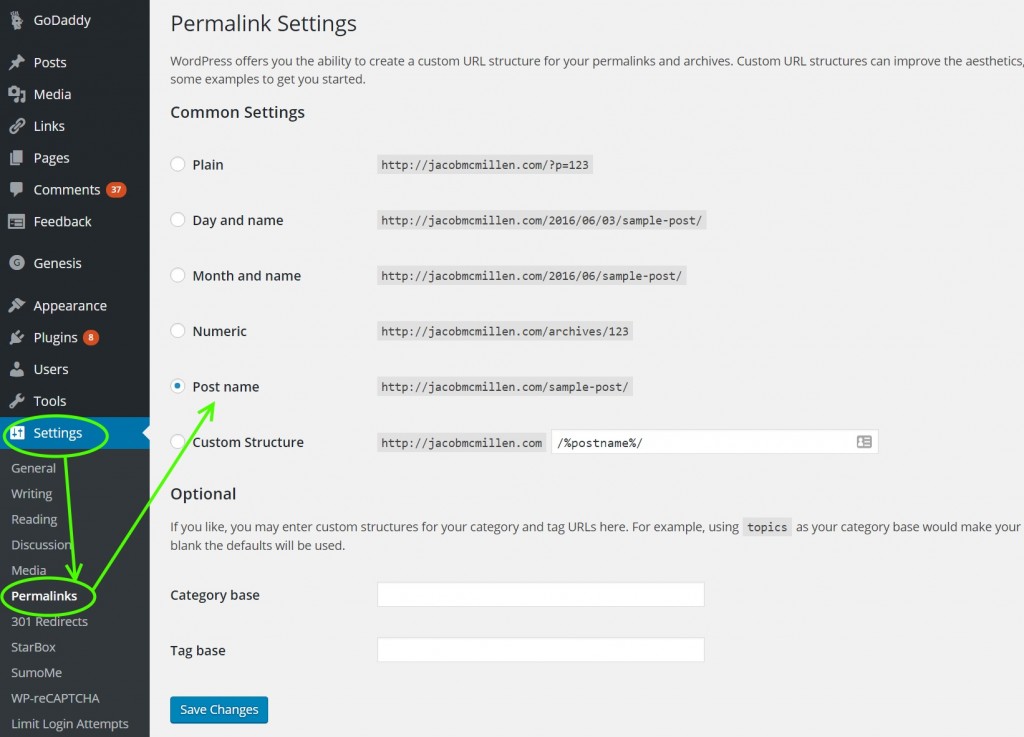
Shorter URLs are usually better for SEO purposes as well as for usability. There is no advantage to having extra dates, archives, random numbers, or other data inside your URLs, so it’s best to eliminate that data.
Step 4: Verify your sitemap is live
One of the core steps in SEO setup is putting up a sitemap. This used to be done manually, but today, your all-purpose SEO plugin will do it for you.
You do, however, need to verify that the plugin has setup your sitemap correctly. For some reason, this particular step tends to misfire for every other site one builds, so it’s important to go ahead and click-through to your sitemap to confirm that no troubleshooting is required.
If you are using Yoast SEO, simply enter “yourdomain.com/sitemap.xml” into your browser to view your sitemap. It should look something like this:

To get more advanced…
These are the basics that you need to start getting ranked, and frankly, this is all most sites will need in terms of sitewide SEO setup.
That said, there is a TON you can do to configure your SEO plugin. If you’d like to see just how much your plugin is capable of up, check out this guide by Yoast.
Once we’ve identified our keyphrases, it’s time to optimize our website around those phrases. In other words, we are trying to set up our website so that when Google’s bots scan us for indexing, they are attaching our site to keyphrases like “Atlanta roofing company” and “fix my roof Atlanta”.
The best part about this step is that it’s completely in our control. We can do everything from our own WordPress dashboard. Simply follow these steps.
Step 1: Install an all-purpose SEO plugin
Once again, the best part about WordPress is that there are so many plugins that make life easy. When it comes to site-wide SEO setup, there are several plugin options that will do virtually all the heavy lifting for you.
The two most popular options include:
My personal favorite is Yoast SEO, so that’s the one I’ll pull screenshots from in this tutorial, but both plugins will do essentially the same thing with only a few variations here or there.
Step 2: Set your homepage meta data
Your meta data is the core information sent to Google and other search engines concerning your website. When we talk about meta data in the context of SEO, we are typically talking about your domain’s title and description.
You’ll want to include your brand name and your top keyphrase in your site’s meta title, while limiting the total character count to around 67 characters.
For your meta description, follow these guidelines:
- Keep it around 135 characters
- Use action-based wording and include a direct Call To Action (CTA)
- Make sure to include your primary keyphrase
In order to enter your homepage meta data, look for “Titles & Metas” in your Yoast SEO plugin settings or a similar variant if you are using a different plugin.

Step 3: Adjust your permalinks
Your permalinks are the way WordPress configures your URLs for new posts and pages. The default setting typically includes some sort of date, category, or other data in the URL which isn’t optimal, so we’ll want to change that right off the bat when setting up a new site. If your site is older and already has a ton of content, you can either skip this step or follow the directions here.
Simply go to Settings > Permalinks and then check the bubble next to “Post name” – http://yourdomain.com/sample-post/

Shorter URLs are usually better for SEO purposes as well as for usability. There is no advantage to having extra dates, archives, random numbers, or other data inside your URLs, so it’s best to eliminate that data.
Step 4: Verify your sitemap is live
One of the core steps in SEO setup is putting up a sitemap. This used to be done manually, but today, your all-purpose SEO plugin will do it for you.
You do, however, need to verify that the plugin has setup your sitemap correctly. For some reason, this particular step tends to misfire for every other site one builds, so it’s important to go ahead and click-through to your sitemap to confirm that no troubleshooting is required.
If you are using Yoast SEO, simply enter “yourdomain.com/sitemap.xml” into your browser to view your sitemap. It should look something like this:

To get more advanced…
These are the basics that you need to start getting ranked, and frankly, this is all most sites will need in terms of sitewide SEO setup.
That said, there is a TON you can do to configure your SEO plugin. If you’d like to see just how much your plugin is capable of up, check out this guide by Yoast.
SEO 4400: Optimize Your On-Page SEO
Now that we’ve taken care of the general, sitewide settings, it’s time to tackle the most important part of SEO site optimization.
On-Page SEO
Your proficiency in on-page SEO will play a massive role in dictating your site’s success. Furthermore, if you implement effective strategies as you create new pages, you can save yourself from having to invest a TON of time down the road in going back through hundreds of pages and making necessary changes. This phase can be accomplished in 10 mins for a single page, but if you are having to go back through and optimize multiple pages, then the entire process can, of course, take quite some time.
So what is on-page SEO?
In a nutshell, on-page SEO is the process of setting up an individual webpage to rank for a desired search keyphrase and its similar alternative phrases. This isn’t the same keyphrase you used to optimize your homepage. Each page will be optimized around its own keyphrase from that list of 30 we selected earlier.
The optimization process involves a number of key elements, and there’s a lot to cover, so let’s get started.
Step 1: Optimize your page title
The single most important part of any webpage is the title. This is what attracts both Google and actual users to that page.
In order to please Google, start the title with your target keyphrase and then follow it up with a compelling headline that will communicate the page’s benefit to your target audience.
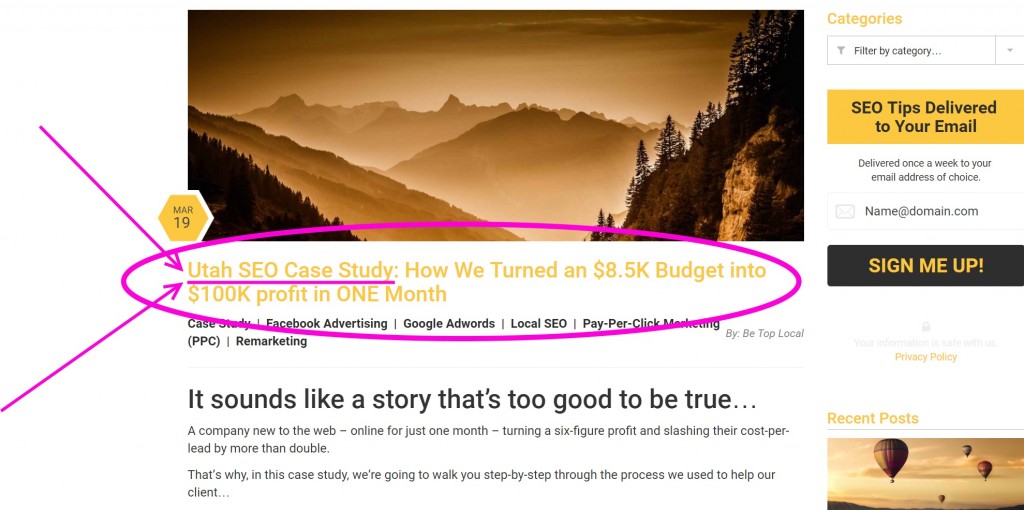
For example, on above page, Be Top Local wanted to rank for “Utah SEO case study” while also attracting its target audience – Utah business owners. Accordingly, they began the post with the desired keyphrase and then followed it up by discussing actual results they achieved for a client in their target segment.
Step 2: Optimize your URL
Remember how we changed our permalinks so that the URL would be “yourdomain.com/post-name”?
Well that’s good, but we want to manually make it even better. After you have created your title, go ahead and click on the URL section just below in your WordPress dashboard and edit the URL to ONLY include your targeted keyphrase. In other words, simply delete the extra headline that follows the keyphrase in our example above.
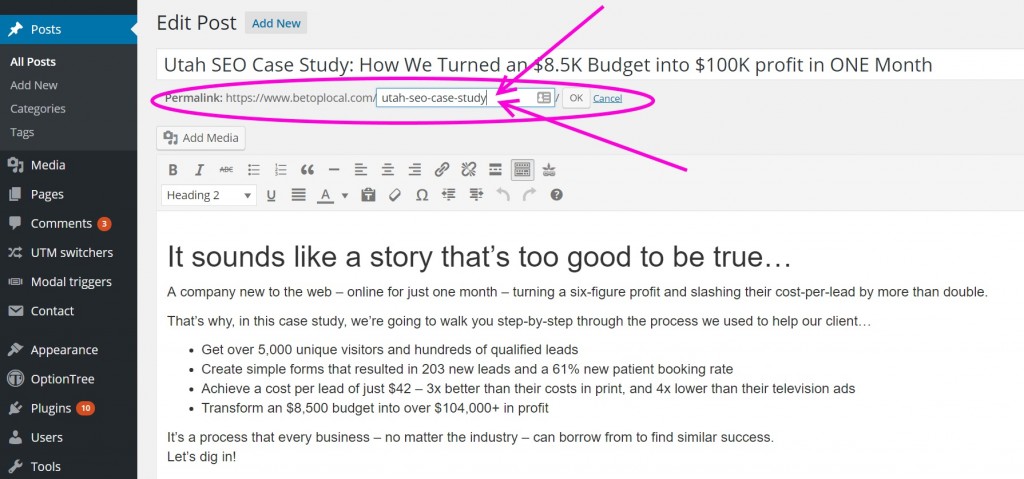
Step 3: Include an attractive image
People like images. Including an image at the beginning of a post tends to decrease bounce rates, which means Google also likes images. Plus, you’ll want an image to pop up when someone shares your URL on social media.
Include a nice image in your posts. Simple.
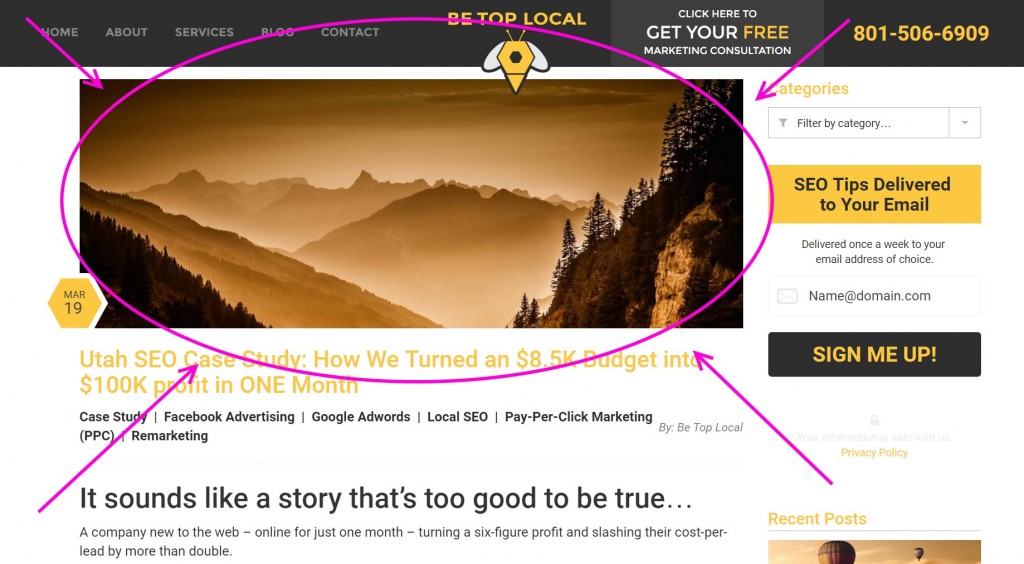
For some themes, including an image in the “Featured Image” section of your post will automatically display it at the start of your post. For other themes, you’ll need to also add it at the top.
You also aren’t limited to an image. Video can be just as (if not more) effective but also comes with a higher investment cost if you are creating your own videos.
While you don’t necessarily need multiple images, it is always nice to include visuals in an article. It also gives you an opportunity to rank your page via Google’s Image Search function. Just be sure to always include “Alt Text” titles for each image that include your target keyphrase.

Step 4: Mention your keyphrase in first 100 words of content
This is pretty straightforward but often overlooked. I actually overlooked it in the article we’ve been using for our example, so I just added it in. Be sure to include your target keyphrase at some point within the first 100 words of your post.
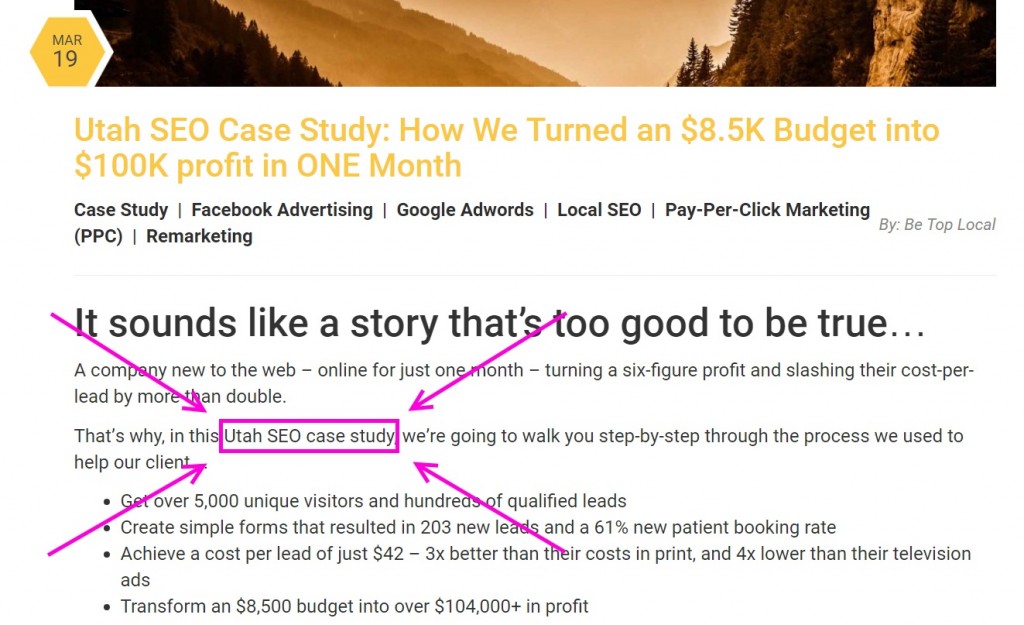
Step 5: Use H2 tags for subheadings and include your keyphrase in one
Your primary subheadings should use the “H2” tag. To include this, you’ll need to toggle the tooblar in your WordPress post editor and then select “Heading 2”.
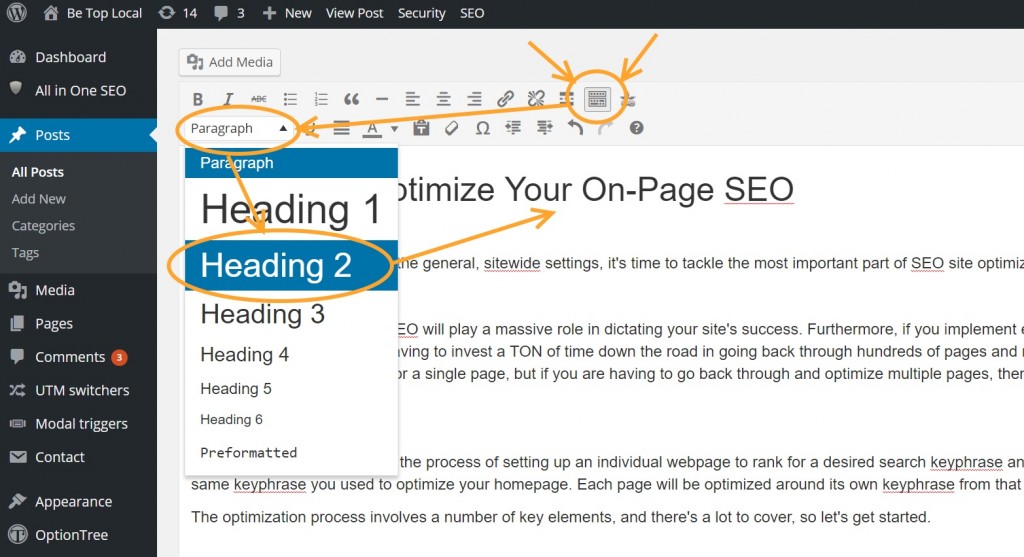
At some point within your post, include your target keyphrase within one of the subheadings.
Step 6: Include internal links
As your domain’s authority grows (as well as the authority of various pages), it’s important to utilize that authority to help rank your other pages. The key to accomplishing this is to interlink your pages to each other via the targeted keyphrases.
In other words, if I want to help rank that “Utah SEO Case Study” article, I will use new articles (like this one) to link to that page from phrases that either directly relate to that target phrase, like this – Utah SEO Case Study – or with a similar, relevant phrase, like this – “the importance of SEO for local Utah businesses“.
When you add a new post, be sure to go back through old articles and link to the new post. For example, when I’m done with this post, I’ll go to Be Top Local’s local SEO link building post and include a link to this new article, using this article’s keyphrase as anchor text.
Step 7: Include outbound links
As you may have noticed, the most in-depth articles often link out to multiple authoritative sites in order to direct their readers to additional resources. Google has caught on to this and uses those outbound links as a gauge for your page’s key topic.
Make sure to include a few outbound links to highly relevant sources within your post.
Step 8: Evaluate your keyphrase saturation
In addition to the previous keyphrase inclusions we’ve covered – Title, first 100 words, image Alt Text, Subheading – we also want the page’s content to include this keyphrase with a certain frequency. As Google has become more sophisticated, however, simply throwing in a bunch of phrases has become more and more risky. Instead, you’ll want to include the actual keyphrase only a handful of times, but ALSO include a number of similar phrases (referred to as LSI Keywords).
Frankly, it’s a bit complicated to keep up with the appropriate frequency of keywords, so I just use Yoast SEO’s built-in analyzer to gauge it for me.
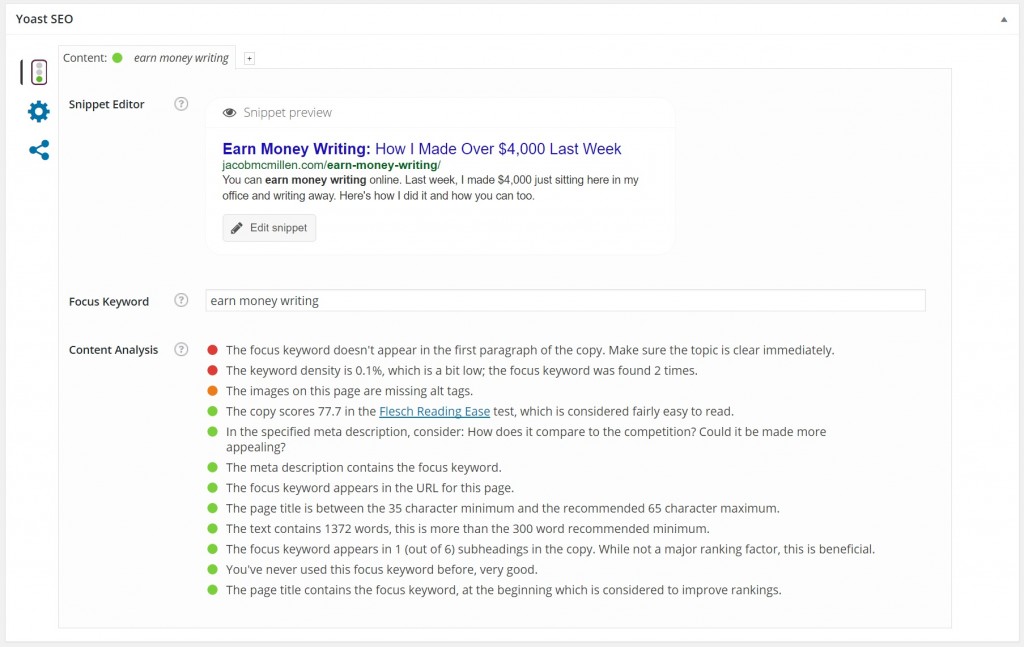
As you can see, not only does this tool give me a general gauge (red light, yellow light, greenlight), but it also gives me specifics on what I’m doing right and what I’m doing wrong within the page’s content. You’ll see many of the steps we’ve discussed mentioned under the “Content Analysis” list.
Step 9: Optimize your meta description
Just like we had a meta description for our homepage, it’s important to include a meta description for every new page we create. Google will automatically pull the first 135 or so characters from your page if you don’t provide a meta description, and those initial characters probably won’t provide an optimized hook to real in searchers.
The SEO plugin you selected will include a spot for your meta description at the bottom of each post. Here’s an example using All-In-One SEO Pack:
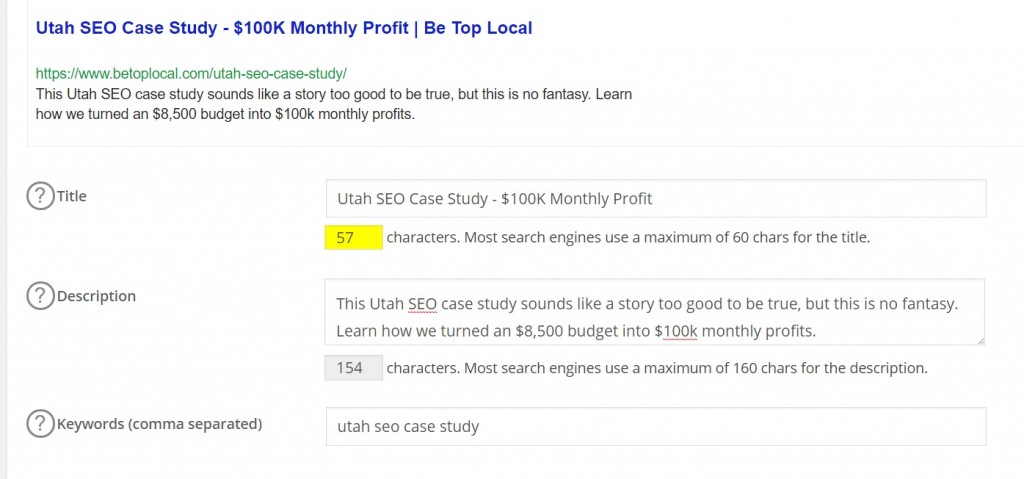
Remember to include the same ingredients from your homepage meta description, but unique to this page:
- Keep it around 135 characters
- Use action-based wording and include a direct Call To Action (CTA)
- Make sure to include your primary keyphrase
Step 10: Include prominent social share buttons for blog content
While this won’t apply to every webpage, it’s important to make social sharing incredibly easy for your site visitors. While shares don’t directly increase your ranking, more shares equals more visitors equals more backlinks equals higher rankings.
In other words, getting social shares is very good for your site, so make it easy.
There are a wide variety of plugins you can use for this. If you want something quick, easy, and free, I’d recommend SumoMe’s Share bar.
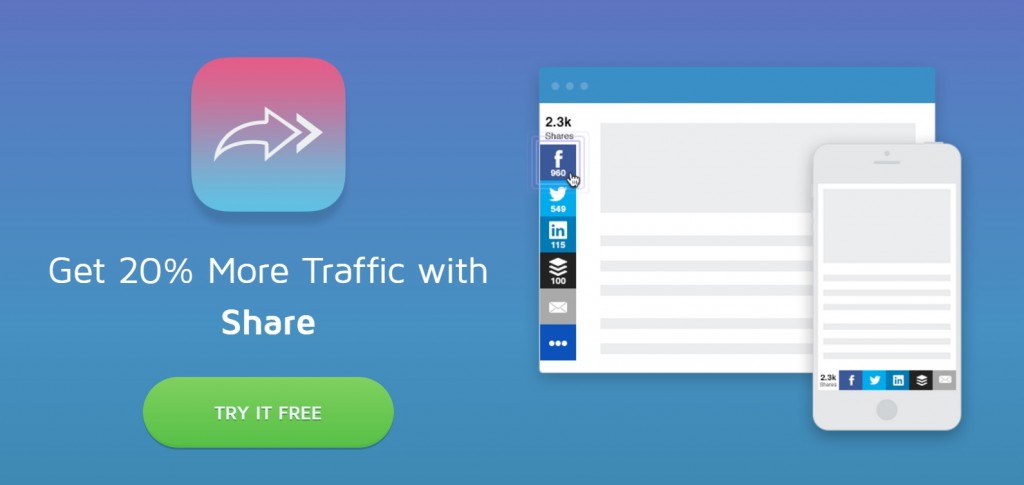
Get more advanced…
That’s probably everything you need to know about on-page SEO, but if you want to dig even deeper, check out this in-depth guide from Moz.
Now that we’ve taken care of the general, sitewide settings, it’s time to tackle the most important part of SEO site optimization.
On-Page SEO
Your proficiency in on-page SEO will play a massive role in dictating your site’s success. Furthermore, if you implement effective strategies as you create new pages, you can save yourself from having to invest a TON of time down the road in going back through hundreds of pages and making necessary changes. This phase can be accomplished in 10 mins for a single page, but if you are having to go back through and optimize multiple pages, then the entire process can, of course, take quite some time.
So what is on-page SEO?
In a nutshell, on-page SEO is the process of setting up an individual webpage to rank for a desired search keyphrase and its similar alternative phrases. This isn’t the same keyphrase you used to optimize your homepage. Each page will be optimized around its own keyphrase from that list of 30 we selected earlier.
The optimization process involves a number of key elements, and there’s a lot to cover, so let’s get started.
Step 1: Optimize your page title
The single most important part of any webpage is the title. This is what attracts both Google and actual users to that page.
In order to please Google, start the title with your target keyphrase and then follow it up with a compelling headline that will communicate the page’s benefit to your target audience.

For example, on above page, Be Top Local wanted to rank for “Utah SEO case study” while also attracting its target audience – Utah business owners. Accordingly, they began the post with the desired keyphrase and then followed it up by discussing actual results they achieved for a client in their target segment.
Step 2: Optimize your URL
Remember how we changed our permalinks so that the URL would be “yourdomain.com/post-name”?
Well that’s good, but we want to manually make it even better. After you have created your title, go ahead and click on the URL section just below in your WordPress dashboard and edit the URL to ONLY include your targeted keyphrase. In other words, simply delete the extra headline that follows the keyphrase in our example above.

Step 3: Include an attractive image
People like images. Including an image at the beginning of a post tends to decrease bounce rates, which means Google also likes images. Plus, you’ll want an image to pop up when someone shares your URL on social media.
Include a nice image in your posts. Simple.

For some themes, including an image in the “Featured Image” section of your post will automatically display it at the start of your post. For other themes, you’ll need to also add it at the top.
You also aren’t limited to an image. Video can be just as (if not more) effective but also comes with a higher investment cost if you are creating your own videos.
While you don’t necessarily need multiple images, it is always nice to include visuals in an article. It also gives you an opportunity to rank your page via Google’s Image Search function. Just be sure to always include “Alt Text” titles for each image that include your target keyphrase.

Step 4: Mention your keyphrase in first 100 words of content
This is pretty straightforward but often overlooked. I actually overlooked it in the article we’ve been using for our example, so I just added it in. Be sure to include your target keyphrase at some point within the first 100 words of your post.

Step 5: Use H2 tags for subheadings and include your keyphrase in one
Your primary subheadings should use the “H2” tag. To include this, you’ll need to toggle the tooblar in your WordPress post editor and then select “Heading 2”.

At some point within your post, include your target keyphrase within one of the subheadings.
Step 6: Include internal links
As your domain’s authority grows (as well as the authority of various pages), it’s important to utilize that authority to help rank your other pages. The key to accomplishing this is to interlink your pages to each other via the targeted keyphrases.
In other words, if I want to help rank that “Utah SEO Case Study” article, I will use new articles (like this one) to link to that page from phrases that either directly relate to that target phrase, like this – Utah SEO Case Study – or with a similar, relevant phrase, like this – “the importance of SEO for local Utah businesses“.
When you add a new post, be sure to go back through old articles and link to the new post. For example, when I’m done with this post, I’ll go to Be Top Local’s local SEO link building post and include a link to this new article, using this article’s keyphrase as anchor text.
Step 7: Include outbound links
As you may have noticed, the most in-depth articles often link out to multiple authoritative sites in order to direct their readers to additional resources. Google has caught on to this and uses those outbound links as a gauge for your page’s key topic.
Make sure to include a few outbound links to highly relevant sources within your post.
Step 8: Evaluate your keyphrase saturation
In addition to the previous keyphrase inclusions we’ve covered – Title, first 100 words, image Alt Text, Subheading – we also want the page’s content to include this keyphrase with a certain frequency. As Google has become more sophisticated, however, simply throwing in a bunch of phrases has become more and more risky. Instead, you’ll want to include the actual keyphrase only a handful of times, but ALSO include a number of similar phrases (referred to as LSI Keywords).
Frankly, it’s a bit complicated to keep up with the appropriate frequency of keywords, so I just use Yoast SEO’s built-in analyzer to gauge it for me.

As you can see, not only does this tool give me a general gauge (red light, yellow light, greenlight), but it also gives me specifics on what I’m doing right and what I’m doing wrong within the page’s content. You’ll see many of the steps we’ve discussed mentioned under the “Content Analysis” list.
Step 9: Optimize your meta description
Just like we had a meta description for our homepage, it’s important to include a meta description for every new page we create. Google will automatically pull the first 135 or so characters from your page if you don’t provide a meta description, and those initial characters probably won’t provide an optimized hook to real in searchers.
The SEO plugin you selected will include a spot for your meta description at the bottom of each post. Here’s an example using All-In-One SEO Pack:

Remember to include the same ingredients from your homepage meta description, but unique to this page:
- Keep it around 135 characters
- Use action-based wording and include a direct Call To Action (CTA)
- Make sure to include your primary keyphrase
Step 10: Include prominent social share buttons for blog content
While this won’t apply to every webpage, it’s important to make social sharing incredibly easy for your site visitors. While shares don’t directly increase your ranking, more shares equals more visitors equals more backlinks equals higher rankings.
In other words, getting social shares is very good for your site, so make it easy.
There are a wide variety of plugins you can use for this. If you want something quick, easy, and free, I’d recommend SumoMe’s Share bar.

Get more advanced…
That’s probably everything you need to know about on-page SEO, but if you want to dig even deeper, check out this in-depth guide from Moz.
Conclusion (And PDF Checklist)
Believe it or not, with a little practice, you can do everything we covered on this page in under an hour. As you make instituting on-page SEO a habit, you will be able to optimize new pages in as little as 15 minutes.
If your site has been around for awhile, it might be a bit more difficult. The more content you have already, the longer and trickier this process can be (that’s where you might consider hiring a local SEO specialist).
Go ahead and get started implementing these steps for your business. We’ve even turned this guide into ahandy checklist you can reference at your convenience. Click below to download it free!

By the way, can you guess what our target keyphrase was for this article?
Once you’ve finished optimizing your website, you’re ready to continue forward in your SEO journey. Head on over to our Local SEO Tips series for your next steps.
Believe it or not, with a little practice, you can do everything we covered on this page in under an hour. As you make instituting on-page SEO a habit, you will be able to optimize new pages in as little as 15 minutes.
If your site has been around for awhile, it might be a bit more difficult. The more content you have already, the longer and trickier this process can be (that’s where you might consider hiring a local SEO specialist).
Go ahead and get started implementing these steps for your business. We’ve even turned this guide into ahandy checklist you can reference at your convenience. Click below to download it free!

By the way, can you guess what our target keyphrase was for this article?
Once you’ve finished optimizing your website, you’re ready to continue forward in your SEO journey. Head on over to our Local SEO Tips series for your next steps.
Able To Prove God, Jesus Christ, The Holy Bible To Be Fact!!!
step-by-step system - how to build a profitable business on amazon
Skyrocketing Your income with Ultra Running Webinar
Learn How I Make $3,500 to $25,000 Monthly With Google & Clickbank
how to make over $1,000 per day with The Nuclear Affiliate System
wpsubscribers - the premium wordpress subscription plugin
GET PAID TO DRAW PICTURES AND TAKE PHOTOGRAPHS
legitimate online jobs
Skyrocketing Your income with Ultra Running Webinar
Learn How I Make $3,500 to $25,000 Monthly With Google & Clickbank
how to make over $1,000 per day with The Nuclear Affiliate System
wpsubscribers - the premium wordpress subscription plugin
GET PAID TO DRAW PICTURES AND TAKE PHOTOGRAPHS
legitimate online jobs
How to Whiten Your Skin Naturally - 100% Guarantee!
natural anti-aging shortcuts
the fat burning kitchen
Top secret fat loss
Love this Post? Spread the Word.
Berapa sih nilai dari blog gue DALAM DOLLAR ? http://richardnata.blogspot.com/2015/04/berapa-sih-nilai-dari-blog-gue-dalam.html
Need a professional writer? Fiction and non-fiction? contact richard.nata@yahoo.co.id
Let me introduce myself. My name is Richard Nata. I am an author, novelist, blogger and ghost writer. My articles, including short stories have been published in magazines and newspapers since 1994. I have written a lot of books, both fiction and non-fiction. So I was a professional in the field of writing, both fiction and non-fiction.
Need a professional writer? Fiction and non-fiction? contact richard.nata@yahoo.co.id
Let me introduce myself. My name is Richard Nata. I am an author, novelist, blogger and ghost writer. My articles, including short stories have been published in magazines and newspapers since 1994. I have written a lot of books, both fiction and non-fiction. So I was a professional in the field of writing, both fiction and non-fiction.
I was born in Jakarta, August 17, 1968.
In 1988, at the age of 20 years, I started working as an accounting staff. Age 24 years has occupied the position of Finance Manager. Age 26 years as a General Manager.
In 1994, my articles published in magazines and tabloids.
In 1997, I wrote a book entitled "Buku Pintar Mencari Kerja". This book is reprinted as much as 8 times. Through the book, the authors successfully helped tens of thousands of people get jobs at once successful in their careers. They were also successful when moving to work in other places.
In 1998, I started investing in shares on Bursa Efek Indonesia (Indonesia stock exchange). As a result of investing in the stock market then I can provide consulting services for companies that want to go public in Indonesia stock exchange.
more information :
1. IPO KAN PERUSAHAAN ANDA DI BEI, TRIK TERCEPAT MENJADIKAN ANDA SEORANG KONGLOMERAT. brand, ideas, story, style, my life: IPO KAN PERUSAHAAN ANDA DI BEI, TRIK TERCEPAT MENJADIKAN ANDA SEORANG KONGLOMERAT.
2. JASA KONSULTAN GO PUBLIC ( IPO ) DI BURSA EFEK INDONESIA.
In 2015, Richard Nata revise the "Buku Pintar Mencari Kerja" became BUKU PINTAR DAPAT KERJA GAJI TINGGI PINDAH KERJA GAJI SEMAKIN TINGGI
BUKU PINTAR DAPAT KERJA GAJI TINGGI PINDAH KERJA GAJI SEMAKIN TINGGI made by retyping the book BEST SELLER of the author, entitled “Buku Pintar Mencari Kerja”. This ebook available on google play.
In 2015, I had the idea of a startup company where the readers can decide for themselves the next story. WASN'T THIS A GREAT IDEA? IF can be realized WILL BE WORTH billions USD. Because CAN PRODUCE FOR MILLIONS OF DOLLARS even tens of millions USD annually.
In theory, in 10-20 years into the future, my startup income, amounting to hundreds of million USD annually can be obtained easily. AND IF FOLLOWED BY MANY COMPANIES IN THE WHOLE WORLD WILL THEN BE A NEW INDUSTRIAL worth trillions USD.
To be honest. Currently I'm not having a lot of money. So I start marketing my startup with blogspot.
My STARTUP :
I was born in Jakarta, August 17, 1968.
In 1988, at the age of 20 years, I started working as an accounting staff. Age 24 years has occupied the position of Finance Manager. Age 26 years as a General Manager.
In 1994, my articles published in magazines and tabloids.
In 1997, I wrote a book entitled "Buku Pintar Mencari Kerja". This book is reprinted as much as 8 times. Through the book, the authors successfully helped tens of thousands of people get jobs at once successful in their careers. They were also successful when moving to work in other places.
In 1998, I started investing in shares on Bursa Efek Indonesia (Indonesia stock exchange). As a result of investing in the stock market then I can provide consulting services for companies that want to go public in Indonesia stock exchange.
more information :
1. IPO KAN PERUSAHAAN ANDA DI BEI, TRIK TERCEPAT MENJADIKAN ANDA SEORANG KONGLOMERAT. brand, ideas, story, style, my life: IPO KAN PERUSAHAAN ANDA DI BEI, TRIK TERCEPAT MENJADIKAN ANDA SEORANG KONGLOMERAT.
2. JASA KONSULTAN GO PUBLIC ( IPO ) DI BURSA EFEK INDONESIA.
In 2015, Richard Nata revise the "Buku Pintar Mencari Kerja" became BUKU PINTAR DAPAT KERJA GAJI TINGGI PINDAH KERJA GAJI SEMAKIN TINGGI
BUKU PINTAR DAPAT KERJA GAJI TINGGI PINDAH KERJA GAJI SEMAKIN TINGGI made by retyping the book BEST SELLER of the author, entitled “Buku Pintar Mencari Kerja”. This ebook available on google play.
In 2015, I had the idea of a startup company where the readers can decide for themselves the next story. WASN'T THIS A GREAT IDEA? IF can be realized WILL BE WORTH billions USD. Because CAN PRODUCE FOR MILLIONS OF DOLLARS even tens of millions USD annually.
In theory, in 10-20 years into the future, my startup income, amounting to hundreds of million USD annually can be obtained easily. AND IF FOLLOWED BY MANY COMPANIES IN THE WHOLE WORLD WILL THEN BE A NEW INDUSTRIAL worth trillions USD.
To be honest. Currently I'm not having a lot of money. So I start marketing my startup with blogspot.
My STARTUP :
A story with millions of choices in it - looking investor like you.
Try to imagine this. When you're reading a story on the web or blog, you are given two choices. You can choose the next story based on your own choice. After selecting then you can continue reading the story. Shortly afterwards you will be presented back to the 2 other options. The next choice is up to you. Then you continue the story you are reading. After that you will be faced again with 2 choices. So onwards. The more stories you read so the more options you have taken.
If you feel curious then you can re-read the story by changing your selection. Then you will see a different story with the story that you have read previously. The question now is why is this so? Because the storyline will be varying according to your choice.
I, as the author is planning to make tens of thousands of articles with millions of choices in it. With tens of thousands of articles then you like to see a show of your favorite series on TV for several years. The difference is while watching your favorite TV series, then you can not change the story. Meanwhile, if you read this story then you can alter the way the story according to your own choice.
You might say like this. Sounds like a book "choose your own adventure". Books I read when I was young.
Correctly. The idea is taken from there. But if you read through a book, the story is not so exciting. Due to the limited number of pages. When a child first you may already feel interesting. But if you re-read the book now then becomes no fun anymore because you don't get anything with the amount of 100-200 pages.
Have you ever heard of game books? When you were boy or girl, did you like reading game books? I think you've heard even happy to read it.
Gamebooks are sometimes informally called choose your own adventure books or CYOA which is also the name of the Choose Your Own Adventure series published byBantam Books. Gamebook - Wikipedia, the free encyclopedia
Gamebook - Wikipedia, the free encyclopedia
A gamebook is a work of fiction that allows the reader to participate in the story by making effective choices. The narrative branches along various paths through the use of numbered paragraphs or pages.
Bantam Books with the Choose Your Own Adventure
series has produced more than 250 million US
dollars. While I offer you more powerful than the Choose
Your Own Adventure. Because of what? Because the
story that I made much more interesting than the stories
created by the authors of Bantam Books. You will not get anything just to 100-200 pages. While the story that I created is made up of tens of thousands of articles with millions of choices in it.
For comparison are the books published with the theme "choose your own adventure" produces more than 250 million copies worldwide. If the average price of a book for 5 USD, the industry has produced more than 1.5 billion USD. But unfortunately this industry has been abandoned because the reader begins to feel bored. The last book was published entitled "The Gorillas of Uganda (prev." Search for the Mountain Gorillas ")". And this book was published in 2013.
Based on the above, then you are faced with two choices. Are you interested in reading my story is? Or you are not interested at all. The choice is in your hands.
If you are interested then spread widely disseminated this article to your family, friends, neighbors, and relatives. You can also distribute it on facebook, twitter, goggle +, or other social media that this article be viral in the world. By doing so it is a new entertainment industry has been created.
Its creator named Richard Nata.
The full articles that talks about this:
19. Start-up strategy in order to earn millions to tens of millions of dollars annually. http://richardnata.blogspot.com/2015/02/start-up-strategy-in-order-to-earn.html
20. Why do I need startup funds from investors? http://richardnata.blogspot.com/2015/05/why-do-i-need-startup-funds-from.html
21. slow but sure vs acceleration. http://richardnata.blogspot.com/2015/05/slow-but-sure-vs-acceleration.html
29. Start reading the story here. http://richardnata.blogspot.com/2015/05/start-reading-story-here.html
WHY DO I NEED STARTUP FUNDS FROM INVESTORS? I NEED A LOT OF FUNDS FROM INVESTORS BECAUSE I HAVE TO LOOKING FOR EXPERT PROGRAMMERS(IT).BECAUSE THE DATA IS HANDLED IS VERY LARGE, IT MAY HAVE TO WEAR SOME PROGRAMMERS(IT).
I CAN NOT WEAR SOME FREELANCE PROGRAMMER BECAUSE THE DATA MUST BE MONITORED CONTINUOUSLY FROM VIRUSES, MALWARE, SPAM, AND OTHERS.
IN ADDITION FUNDS FROM INVESTORS IS ALSO USED TO BUY SERVERS WITH VERY LARGE CAPACITY. FUNDS ARE ALSO USED TO PAY EMPLOYEE SALARIES AND OPERATIONAL COSTS OF THE COMPANY.
FUNDS CAN ALSO BE USED FOR ADVERTISING AND OTHER MARKETING STRATEGIES.FUNDS CAN ALSO BE USED TO ADVERTISE MY STARTUP AND OTHER MARKETING STRATEGIES.
IF I GET A VERY LARGE FUND, THE PART OF THE FUNDS USED TO TRANSLATE THE STORY INTO VARIOUS LANGUAGES.With more and more languages, the more readers we get.
WITH MORE AND MORE READERS, THE MORE REVENUE WE GET.
AS AN INVESTOR THEN YOU DO NOT HAVE TO FEEL ANXIOUS ABOUT YOUR FUNDS. BECAUSE YOUR FUNDS WILL NEVER BE LOST BECAUSE IN 3-5 YEARS YOU HAVE RETURNED THE FUNDS COUPLED WITH PROFIT.
THIS BUSINESS IS ONE AND THE ONLY ONE IN THE WORLD.
If we can make a good story, so that the readers will
come again and again for further reading the story then
our earnings will continue to grow and will never
diminish. This is due to new readers who continued to
arrive, while long remained loyal readers become our
customers.
So that the number of our readers will continue to
multiply over time. With the increasing number of loyal
readership then automatically the amount of income we
will also grow larger every year. The same thing
happened in yahoo, google, facebook, twitter, linkedin,
and others when they still startup.
Deuteronomy {28:13} And the LORD shall make thee the
head, and not the tail; and thou shalt be above only, and
thou shalt not be beneath; if that thou hearken unto the commandments of the LORD thy God, which I command thee this day, to observe and to do [them: ]
Try to imagine this. If I give a very unique story. It was the first time in the world. But the world already know this story even liked it. Because the world love the game books. While the story that I made is the development of game books.
Do you Believe if I dare say if I will succeed because my story will be famous all over the world as Harry Potter?
I believe it. Not because I was the author of the story, but because of the story that I made is unique and the only one in the world.
Income from my startup :
1. Ads. With millions of unique visitors, the price of the ads will be expensive.
3. Contribution of the readers. If you have a million readers and every reader to pay one US dollar per year then you will get the income of one million US dollars per year.
If you have a million readers and every reader to pay one US dollar per month then you will get as much revenue twelve million US dollars per year.
4. Books and Comics. After getting hundreds of thousands to the millions of readers of the story will be made in books and the form of a picture story (comics).
6. Merchandise related to characters. After the movies there will be made an offer for the sale of goods related to the characters.
7. Sales. With millions of email that we have collected from our readers so we can sell anything to them.
Each income (1-7) worth millions to tens of millions of US dollars.
Because each income (1-7) worth millions to tens of millions of US dollars. Then in 10-20 years into the future, AI will be earning hundreds of million USD annually.
So how long do you think my story that I made could gather a thousand readers? Ten thousand readers? One hundred thousand readers? A million readers? Five million readers? Ten million readers? More than ten million readers?
But to get all of it of course takes time, can not be instant. In addition, it takes hard work, big funds and placement of the right people in the right positions.
By advertising, viral marketing, strong marketing strategies and SEO then a million readers can be done in less than a year. Ten million readers can be done in two to three years.
This is the marketing strategy of my startup.
When hundreds of thousands or millions of readers already liked my story then they have to pay to enjoy the story that I made.
If you are a visionary then you will think like this.
With the help of my great name in the world of business, my expertise in marketing, advertising, marketing by mouth, viral marketing, then collecting a million readers to ten million readers will be easy to obtain. Is not that right?
The question now is what if people like my story as they like Harry Potter? You will get tens of millions or even hundreds of millions of email addresses from readers. With that much email, we can sell anything to the readers.
Since April 2013, Wikipedia has around 26 million articles in 285 languages are written by 39 million registered users and a variety of anonymous people who are not known from other parts of the world. Web ranked by Alexa, Wikipedia is a famous website number 6 which has been visited by 12% of all Internet users with 80 million visitors every month and it is only from the calculation of America.
resource : http://www.tahupedia.com/content/show/136/Sejarah-dan-Asal-Mula-Wikipedia
If no Wikipedia then need hundreds of thousands to millions of books required to make 26 million articles in 285 languages into books.
With the Wikipedia then people started to leave to read a book or books to seek knowledge about a subject or many subjects.
The same thing will happen. Read a story in a book or books to be abandoned. Read a story with millions of choices on the web or blog is far more interesting than reading a book or books.
So what happens next? In 10-20 years ahead then read a story in a book to be abandoned. Otherwise my startup will grow and continue to develop into a new entertainment industry.
New entertainment industry, where I was a forerunner startup will continue to evolve.
Therefore, in 10-20 years into the future, my startup will be earning hundreds of million USD annually.
So do not delay. Invest your money immediately to my startup. Take A Look. There are so many advantages if you want to invest in my startup.
WHY YOU SHOULD INVEST YOUR MONEY RIGHT NOW? .
IF YOU INVEST YOUR FUNDS IN ONE, TWO OR THREE YEARS INTO THE FUTURE, YOU MAY BE TOO LATE.
BECAUSE IN 1-3 YEARS INTO THE FUTURE THEN I'VE GOT THE FUNDS. THE FUNDS CAN COME FROM SOME INVESTORS, LOANS FROM BANKS OR FROM ADVERTISEMENTS POSTED ON MY BLOG.
IF I'VE GOT A LARGE AMOUNT OF FUNDS THEN I'VE NO NEED OF YOUR FUNDS. SO INVEST NOW OR NOT AT ALL.
My BLOG started to be written January 11, 2015. TODAY, MAY 30, 2015, THE NUMBER OF CLICKS HAS REACHED 56,750. SO FAR SO GOOD.
If I get big funds from investors then with a quick story that I wrote will spread throughout the world.
So I got acceleration because I can put ads in a large variety of media such as Google AdWords, Facebook, and others. I also can perform a variety of other marketing strategies.
If I do not get funding from investors then my story would still spread throughout the world. But with a longer time, Slow but sure.
So either I get funding from investors or not, the story that I wrote will remain spread throughout the world. Ha ... 7x
So don't worry, be happy.
My advice to you is you should think whether the data that I have provided to you makes sense or not .
If my data reasonable then immediately invest your funds as soon as possible.
Then we discuss how we plan further cooperation.
Thank you.
Try to imagine this. When you're reading a story on the web or blog, you are given two choices. You can choose the next story based on your own choice. After selecting then you can continue reading the story. Shortly afterwards you will be presented back to the 2 other options. The next choice is up to you. Then you continue the story you are reading. After that you will be faced again with 2 choices. So onwards. The more stories you read so the more options you have taken.
If you feel curious then you can re-read the story by changing your selection. Then you will see a different story with the story that you have read previously. The question now is why is this so? Because the storyline will be varying according to your choice.
You might say like this. Sounds like a book "choose your own adventure". Books I read when I was young.
Correctly. The idea is taken from there. But if you read through a book, the story is not so exciting. Due to the limited number of pages. When a child first you may already feel interesting. But if you re-read the book now then becomes no fun anymore because you don't get anything with the amount of 100-200 pages.
Correctly. The idea is taken from there. But if you read through a book, the story is not so exciting. Due to the limited number of pages. When a child first you may already feel interesting. But if you re-read the book now then becomes no fun anymore because you don't get anything with the amount of 100-200 pages.
Have you ever heard of game books? When you were boy or girl, did you like reading game books? I think you've heard even happy to read it.
Gamebooks are sometimes informally called choose your own adventure books or CYOA which is also the name of the Choose Your Own Adventure series published byBantam Books. Gamebook - Wikipedia, the free encyclopedia
Gamebook - Wikipedia, the free encyclopedia
A gamebook is a work of fiction that allows the reader to participate in the story by making effective choices. The narrative branches along various paths through the use of numbered paragraphs or pages.
| ||||||
Bantam Books with the Choose Your Own Adventure
series has produced more than 250 million US
dollars. While I offer you more powerful than the Choose
Your Own Adventure. Because of what? Because the
story that I made much more interesting than the stories
created by the authors of Bantam Books. You will not get anything just to 100-200 pages. While the story that I created is made up of tens of thousands of articles with millions of choices in it.
series has produced more than 250 million US
dollars. While I offer you more powerful than the Choose
Your Own Adventure. Because of what? Because the
story that I made much more interesting than the stories
created by the authors of Bantam Books. You will not get anything just to 100-200 pages. While the story that I created is made up of tens of thousands of articles with millions of choices in it.
For comparison are the books published with the theme "choose your own adventure" produces more than 250 million copies worldwide. If the average price of a book for 5 USD, the industry has produced more than 1.5 billion USD. But unfortunately this industry has been abandoned because the reader begins to feel bored. The last book was published entitled "The Gorillas of Uganda (prev." Search for the Mountain Gorillas ")". And this book was published in 2013.
Based on the above, then you are faced with two choices. Are you interested in reading my story is? Or you are not interested at all. The choice is in your hands.
If you are interested then spread widely disseminated this article to your family, friends, neighbors, and relatives. You can also distribute it on facebook, twitter, goggle +, or other social media that this article be viral in the world. By doing so it is a new entertainment industry has been created.
Its creator named Richard Nata.
The full articles that talks about this:
19. Start-up strategy in order to earn millions to tens of millions of dollars annually. http://richardnata.blogspot.com/2015/02/start-up-strategy-in-order-to-earn.html
20. Why do I need startup funds from investors? http://richardnata.blogspot.com/2015/05/why-do-i-need-startup-funds-from.html
21. slow but sure vs acceleration. http://richardnata.blogspot.com/2015/05/slow-but-sure-vs-acceleration.html
20. Why do I need startup funds from investors? http://richardnata.blogspot.com/2015/05/why-do-i-need-startup-funds-from.html
21. slow but sure vs acceleration. http://richardnata.blogspot.com/2015/05/slow-but-sure-vs-acceleration.html
WHY DO I NEED STARTUP FUNDS FROM INVESTORS? I NEED A LOT OF FUNDS FROM INVESTORS BECAUSE I HAVE TO LOOKING FOR EXPERT PROGRAMMERS(IT).BECAUSE THE DATA IS HANDLED IS VERY LARGE, IT MAY HAVE TO WEAR SOME PROGRAMMERS(IT).
I CAN NOT WEAR SOME FREELANCE PROGRAMMER BECAUSE THE DATA MUST BE MONITORED CONTINUOUSLY FROM VIRUSES, MALWARE, SPAM, AND OTHERS.
IN ADDITION FUNDS FROM INVESTORS IS ALSO USED TO BUY SERVERS WITH VERY LARGE CAPACITY. FUNDS ARE ALSO USED TO PAY EMPLOYEE SALARIES AND OPERATIONAL COSTS OF THE COMPANY.
I CAN NOT WEAR SOME FREELANCE PROGRAMMER BECAUSE THE DATA MUST BE MONITORED CONTINUOUSLY FROM VIRUSES, MALWARE, SPAM, AND OTHERS.
IN ADDITION FUNDS FROM INVESTORS IS ALSO USED TO BUY SERVERS WITH VERY LARGE CAPACITY. FUNDS ARE ALSO USED TO PAY EMPLOYEE SALARIES AND OPERATIONAL COSTS OF THE COMPANY.
FUNDS CAN ALSO BE USED FOR ADVERTISING AND OTHER MARKETING STRATEGIES.FUNDS CAN ALSO BE USED TO ADVERTISE MY STARTUP AND OTHER MARKETING STRATEGIES.
IF I GET A VERY LARGE FUND, THE PART OF THE FUNDS USED TO TRANSLATE THE STORY INTO VARIOUS LANGUAGES.With more and more languages, the more readers we get.
WITH MORE AND MORE READERS, THE MORE REVENUE WE GET.
AS AN INVESTOR THEN YOU DO NOT HAVE TO FEEL ANXIOUS ABOUT YOUR FUNDS. BECAUSE YOUR FUNDS WILL NEVER BE LOST BECAUSE IN 3-5 YEARS YOU HAVE RETURNED THE FUNDS COUPLED WITH PROFIT.
THIS BUSINESS IS ONE AND THE ONLY ONE IN THE WORLD.
If we can make a good story, so that the readers will
come again and again for further reading the story then
our earnings will continue to grow and will never
diminish. This is due to new readers who continued to
arrive, while long remained loyal readers become our
customers.
come again and again for further reading the story then
our earnings will continue to grow and will never
diminish. This is due to new readers who continued to
arrive, while long remained loyal readers become our
customers.
So that the number of our readers will continue to
multiply over time. With the increasing number of loyal
readership then automatically the amount of income we
will also grow larger every year. The same thing
happened in yahoo, google, facebook, twitter, linkedin,
and others when they still startup.
multiply over time. With the increasing number of loyal
readership then automatically the amount of income we
will also grow larger every year. The same thing
happened in yahoo, google, facebook, twitter, linkedin,
and others when they still startup.
Deuteronomy {28:13} And the LORD shall make thee the
head, and not the tail; and thou shalt be above only, and
thou shalt not be beneath; if that thou hearken unto the commandments of the LORD thy God, which I command thee this day, to observe and to do [them: ]
head, and not the tail; and thou shalt be above only, and
thou shalt not be beneath; if that thou hearken unto the commandments of the LORD thy God, which I command thee this day, to observe and to do [them: ]
Try to imagine this. If I give a very unique story. It was the first time in the world. But the world already know this story even liked it. Because the world love the game books. While the story that I made is the development of game books.
Do you Believe if I dare say if I will succeed because my story will be famous all over the world as Harry Potter?
I believe it. Not because I was the author of the story, but because of the story that I made is unique and the only one in the world.
Income from my startup :
1. Ads. With millions of unique visitors, the price of the ads will be expensive.
3. Contribution of the readers. If you have a million readers and every reader to pay one US dollar per year then you will get the income of one million US dollars per year.
If you have a million readers and every reader to pay one US dollar per month then you will get as much revenue twelve million US dollars per year.
4. Books and Comics. After getting hundreds of thousands to the millions of readers of the story will be made in books and the form of a picture story (comics).
6. Merchandise related to characters. After the movies there will be made an offer for the sale of goods related to the characters.
7. Sales. With millions of email that we have collected from our readers so we can sell anything to them.
Each income (1-7) worth millions to tens of millions of US dollars.
Because each income (1-7) worth millions to tens of millions of US dollars. Then in 10-20 years into the future, AI will be earning hundreds of million USD annually.
So how long do you think my story that I made could gather a thousand readers? Ten thousand readers? One hundred thousand readers? A million readers? Five million readers? Ten million readers? More than ten million readers?
But to get all of it of course takes time, can not be instant. In addition, it takes hard work, big funds and placement of the right people in the right positions.
By advertising, viral marketing, strong marketing strategies and SEO then a million readers can be done in less than a year. Ten million readers can be done in two to three years.
This is the marketing strategy of my startup.
When hundreds of thousands or millions of readers already liked my story then they have to pay to enjoy the story that I made.
If you are a visionary then you will think like this.
With the help of my great name in the world of business, my expertise in marketing, advertising, marketing by mouth, viral marketing, then collecting a million readers to ten million readers will be easy to obtain. Is not that right?
The question now is what if people like my story as they like Harry Potter? You will get tens of millions or even hundreds of millions of email addresses from readers. With that much email, we can sell anything to the readers.
Since April 2013, Wikipedia has around 26 million articles in 285 languages are written by 39 million registered users and a variety of anonymous people who are not known from other parts of the world. Web ranked by Alexa, Wikipedia is a famous website number 6 which has been visited by 12% of all Internet users with 80 million visitors every month and it is only from the calculation of America.
resource : http://www.tahupedia.com/content/show/136/Sejarah-dan-Asal-Mula-Wikipedia
If no Wikipedia then need hundreds of thousands to millions of books required to make 26 million articles in 285 languages into books.
With the Wikipedia then people started to leave to read a book or books to seek knowledge about a subject or many subjects.
The same thing will happen. Read a story in a book or books to be abandoned. Read a story with millions of choices on the web or blog is far more interesting than reading a book or books.
So what happens next? In 10-20 years ahead then read a story in a book to be abandoned. Otherwise my startup will grow and continue to develop into a new entertainment industry.
New entertainment industry, where I was a forerunner startup will continue to evolve.
Therefore, in 10-20 years into the future, my startup will be earning hundreds of million USD annually.
So do not delay. Invest your money immediately to my startup. Take A Look. There are so many advantages if you want to invest in my startup.
WHY YOU SHOULD INVEST YOUR MONEY RIGHT NOW? .
IF YOU INVEST YOUR FUNDS IN ONE, TWO OR THREE YEARS INTO THE FUTURE, YOU MAY BE TOO LATE.
BECAUSE IN 1-3 YEARS INTO THE FUTURE THEN I'VE GOT THE FUNDS. THE FUNDS CAN COME FROM SOME INVESTORS, LOANS FROM BANKS OR FROM ADVERTISEMENTS POSTED ON MY BLOG.
IF I'VE GOT A LARGE AMOUNT OF FUNDS THEN I'VE NO NEED OF YOUR FUNDS. SO INVEST NOW OR NOT AT ALL.
BECAUSE IN 1-3 YEARS INTO THE FUTURE THEN I'VE GOT THE FUNDS. THE FUNDS CAN COME FROM SOME INVESTORS, LOANS FROM BANKS OR FROM ADVERTISEMENTS POSTED ON MY BLOG.
IF I'VE GOT A LARGE AMOUNT OF FUNDS THEN I'VE NO NEED OF YOUR FUNDS. SO INVEST NOW OR NOT AT ALL.
My BLOG started to be written January 11, 2015. TODAY, MAY 30, 2015, THE NUMBER OF CLICKS HAS REACHED 56,750. SO FAR SO GOOD.
If I get big funds from investors then with a quick story that I wrote will spread throughout the world.
So I got acceleration because I can put ads in a large variety of media such as Google AdWords, Facebook, and others. I also can perform a variety of other marketing strategies.
So I got acceleration because I can put ads in a large variety of media such as Google AdWords, Facebook, and others. I also can perform a variety of other marketing strategies.
If I do not get funding from investors then my story would still spread throughout the world. But with a longer time, Slow but sure.
So either I get funding from investors or not, the story that I wrote will remain spread throughout the world. Ha ... 7x
So don't worry, be happy.
So either I get funding from investors or not, the story that I wrote will remain spread throughout the world. Ha ... 7x
So don't worry, be happy.
My advice to you is you should think whether the data that I have provided to you makes sense or not .
If my data reasonable then immediately invest your funds as soon as possible.
Then we discuss how we plan further cooperation.
Thank you.
P.P.S. In addition, there is one more thing I
want to tell you. If a story can generate tens
of millions of US dollars, then what if made
P.P.S. In addition, there is one more thing I
want to tell you. If a story can generate tens
of millions of US dollars, then what if made
many stories? Then why do not you make 2, 3 or many stories? You will get hundreds of million USD annually.
many stories? Then why do not you make 2, 3 or many stories? You will get hundreds of million USD annually.



No comments:
Post a Comment